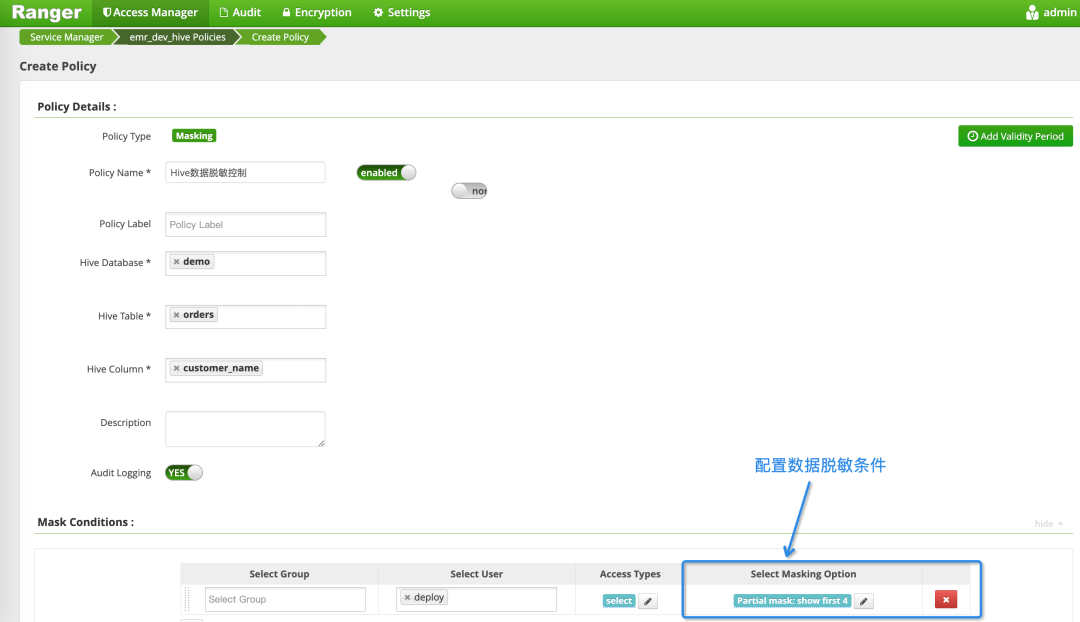项目介绍
日志脱敏是常见的安全需求。普通的基于工具类方法的方式,对代码的入侵性太强,编写起来又特别麻烦。
sensitive[1] 提供了基于注解的方式,并且内置了常见的脱敏方式,便于开发。
日志脱敏
为了金融交易的安全性,国家强制规定对于以下信息是要日志脱敏的:
1.用户名2.手机号3.邮箱4.银行卡号5.密码6.身份证号
特性
1.基于注解的日志脱敏。2.可以自定义策略实现,策略生效条件。3.内置常见的十几种脱敏内置方案。4.JAVA 深拷贝,且原始对象不用实现任何接口。5.支持用户自定义注解。6.支持基于 FastJSON 直接生成脱敏后的 json

快速开始
环境准备
JDK 7+
Maven 3.x
maven 导入
<dependency>
<groupId>com.Github.houbb</groupId>
<artifactId>sensitive-core</artifactId>
<version>1.0.0</version>
</dependency>
核心 api 简介
SensitiveUtil 工具类的核心方法列表如下:
|
序号 |
方法 |
参数 |
结果 |
说明 |
|
1 |
desCopy() |
目标对象 |
深度拷贝脱敏对象 |
适应性更强 |
|
2 |
desJson() |
目标对象 |
脱敏对象 json |
性能较好 |
|
3 |
desCopyCollection() |
目标对象集合 |
深度拷贝脱敏对象集合 |
|
|
4 |
desJsonCollection() |
目标对象集合 |
脱敏对象 json 集合 |
|
定义对象
•UserAnnotationBean.java
通过注解,指定每一个字段的脱敏策略。
public class UserAnnotationBean {
@SensitiveStrategyChineseName
private String username;
@SensitiveStrategyPassword
private String password;
@SensitiveStrategyPassport
private String passport;
@SensitiveStrategyIdNo
private String idNo;
@SensitiveStrategyCardId
private String bandCardId;
@SensitiveStrategyPhone
private String phone;
@SensitiveStrategyEmAIl
private String email;
@SensitiveStrategyAddress
private String address;
@SensitiveStrategyBirthday
private String birthday;
@SensitiveStrategyGps
private String gps;
@SensitiveStrategyIp
private String ip;
@SensitiveStrategyMaskAll
private String maskAll;
@SensitiveStrategyMaskHalf
private String maskHalf;
@SensitiveStrategyMaskRange
private String maskRange;
//Getter & Setter
//toString()
}
•数据准备
构建一个最简单的测试对象:
UserAnnotationBean bean = new UserAnnotationBean();
bean.setUsername("张三");
bean.setPassword("123456");
bean.setPassport("CN1234567");
bean.setPhone("13066668888");
bean.setAddress("中国上海市浦东新区外滩18号");
bean.setEmail("whatanice@code.com");
bean.setBirthday("20220831");
bean.setGps("66.888888");
bean.setIp("127.0.0.1");
bean.setMaskAll("可恶啊我会被全部掩盖");
bean.setMaskHalf("还好我只会被掩盖一半");
bean.setMaskRange("我比较灵活指定掩盖范围");
bean.setBandCardId("666123456789066");
bean.setIdNo("360123202306018888");
•测试代码
final String originalStr = "UserAnnotationBean{username='张三', password='123456', passport='CN1234567', idNo='360123202306018888', bandCardId='666123456789066', phone='13066668888', email='whatanice@code.com', address='中国上海市浦东新区外滩18号', birthday='20220831', gps='66.888888', ip='127.0.0.1', maskAll='可恶啊我会被全部掩盖', maskHalf='还好我只会被掩盖一半', maskRange='我比较灵活指定掩盖范围'}";
final String sensitiveStr = "UserAnnotationBean{username='张*', password='null', passport='CN*****67', idNo='3****************8', bandCardId='666123*******66', phone='1306****888', email='wh************.com', address='中国上海********8号', birthday='20*****1', gps='66*****88', ip='127***0.1', maskAll='**********', maskHalf='还好我只会*****', maskRange='我*********围'}";
final String expectSensitiveJson = "{"address":"中国上海********8号","bandCardId":"666123*******66","birthday":"20*****1","email":"wh************.com","gps":"66*****88","idNo":"3****************8","ip":"127***0.1","maskAll":"**********","maskHalf":"还好我只会*****","maskRange":"我*********围","passport":"CN*****67","phone":"1306****888","username":"张*"}";
UserAnnotationBean sensitiveUser = SensitiveUtil.desCopy(bean);
Assert.assertEquals(sensitiveStr, sensitiveUser.toString());
Assert.assertEquals(originalStr, bean.toString());
String sensitiveJson = SensitiveUtil.desJson(bean);
Assert.assertEquals(expectSensitiveJson, sensitiveJson);
我们可以直接利用 sensitiveUser 去打印日志信息,而这个对象对于代码其他流程不影响,我们依然可以使用原来的 user 对象。
当然,也可以使用 sensitiveJson 打印日志信息。
@Sensitive 注解
说明
@SensitiveStrategyChineseName 这种注解是为了便于用户使用,本质上等价于 @Sensitive(strategy = StrategyChineseName.class)。
@Sensitive 注解可以指定对应的脱敏策略。
内置注解与映射
|
编号 |
注解 |
等价 @Sensitive |
备注 |
|
1 |
@SensitiveStrategyChineseName |
@Sensitive(strategy = StrategyChineseName.class) |
中文名称脱敏 |
|
2 |
@SensitiveStrategyPassword |
@Sensitive(strategy = StrategyPassword.class) |
密码脱敏 |
|
3 |
@SensitiveStrategyEmail |
@Sensitive(strategy = StrategyEmail.class) |
email 脱敏 |
|
4 |
@SensitiveStrategyCardId |
@Sensitive(strategy = StrategyCardId.class) |
卡号脱敏 |
|
5 |
@SensitiveStrategyPhone |
@Sensitive(strategy = StrategyPhone.class) |
手机号脱敏 |
|
6 |
@SensitiveStrategyIdNo |
@Sensitive(strategy = StrategyIdNo.class) |
身份证脱敏 |
|
6 |
@SensitiveStrategyAddress |
@Sensitive(strategy = StrategyAddress.class) |
地址脱敏 |
|
7 |
@SensitiveStrategyGps |
@Sensitive(strategy = StrategyGps.class) |
GPS 脱敏 |
|
8 |
@SensitiveStrategyIp |
@Sensitive(strategy = StrategyIp.class) |
IP 脱敏 |
|
9 |
@SensitiveStrategyBirthday |
@Sensitive(strategy = StrategyBirthday.class) |
生日脱敏 |
|
10 |
@SensitiveStrategyPassport |
@Sensitive(strategy = StrategyPassport.class) |
护照脱敏 |
|
11 |
@SensitiveStrategyMaskAll |
@Sensitive(strategy = StrategyMaskAll.class) |
全部脱敏 |
|
12 |
@SensitiveStrategyMaskHalf |
@Sensitive(strategy = StrategyMaskHalf.class) |
一半脱敏 |
|
13 |
@SensitiveStrategyMaskRange |
@Sensitive(strategy = StrategyMaskRange.class) |
指定范围脱敏 |
@Sensitive 定义
@Inherited
@Documented
@Target(ElementType.FIELD)
@Retention(RetentionPolicy.RUNTIME)
public @interface Sensitive {
/**
* 注解生效的条件
* @return 条件对应的实现类
*/
Class<? extends ICondition> condition() default ConditionAlwaysTrue.class;
/**
* 执行的策略
* @return 策略对应的类型
*/
Class<? extends IStrategy> strategy();
}
与 @Sensitive 混合使用
如果你将新增的注解 @SensitiveStrategyChineseName 与 @Sensitive 同时在一个字段上使用。
为了简化逻辑,优先选择执行 @Sensitive,如果 @Sensitive 执行脱敏, 那么 @SensitiveStrategyChineseName 将不会生效。
如:
/**
* 测试字段
* 1.当多种注解混合的时候,为了简化逻辑,优先选择 @Sensitive 注解。
*/
@SensitiveStrategyChineseName
@Sensitive(strategy = StrategyPassword.class)
private String testField;
更多特性
自定义脱敏策略生效的场景
默认情况下,我们指定的场景都是生效的。
但是你可能需要有些情况下不进行脱敏,比如有些用户密码为 123456,你觉得这种用户不脱敏也罢。
•UserPasswordCondition.java
@Sensitive(condition = ConditionFooPassword.class, strategy = StrategyPassword.class)
private String password;
其他保持不变,我们指定了一个 condition,实现如下:
•ConditionFooPassword.java
public class ConditionFooPassword implements ICondition {
@Override
public boolean valid(IContext context) {
try {
Field field = context.getCurrentField();
final Object currentObj = context.getCurrentObject();
final String password = (String) field.get(currentObj);
return !password.equals("123456");
} catch (IllegalAccessException e) {
throw new RuntimeException(e);
}
}
}
也就是只有当密码不是 123456 时密码脱敏策略才会生效。
属性为集合或者对象
如果某个属性是单个集合或者对象,则需要使用注解 @SensitiveEntry。
•放在集合属性上,且属性为普通对象
会遍历每一个属性,执行上面的脱敏策略。
•放在对象属性上
会处理对象中各个字段上的脱敏注解信息。
•放在集合属性上,且属性为对象
遍历每一个对象,处理对象中各个字段上的脱敏注解信息。
放在集合属性上,且属性为普通对象
•UserEntryBaseType.java
作为演示,集合中为普通的字符串。
public class UserEntryBaseType {
@SensitiveEntry
@Sensitive(strategy = StrategyChineseName.class)
private List<String> chineseNameList;
@SensitiveEntry
@Sensitive(strategy = StrategyChineseName.class)
private String[] chineseNameArray;
//Getter & Setter & toString()
}
放在对象属性上
例子如下:
public class UserEntryObject {
@SensitiveEntry
private User user;
@SensitiveEntry
private List<User> userList;
@SensitiveEntry
private User[] userArray;
//...
}
自定义注解
•v0.0.4 新增功能。允许功能自定义条件注解和策略注解。•v0.0.11 新增功能。允许功能自定义级联脱敏注解。
案例1
自定义密码脱敏策略&自定义密码脱敏策略生效条件
•策略脱敏
/**
* 自定义密码脱敏策略
* @author binbin.hou
* date 2019/1/17
* @since 0.0.4
*/
@Inherited
@Documented
@Target(ElementType.FIELD)
@Retention(RetentionPolicy.RUNTIME)
@SensitiveStrategy(CustomPasswordStrategy.class)
public @interface SensitiveCustomPasswordStrategy {
}
•脱敏生效条件
/**
* 自定义密码脱敏策略生效条件
* @author binbin.hou
* date 2019/1/17
* @since 0.0.4
*/
@Inherited
@Documented
@Target(ElementType.FIELD)
@Retention(RetentionPolicy.RUNTIME)
@SensitiveCondition(ConditionFooPassword.class)
public @interface SensitiveCustomPasswordCondition{
}
•TIPS
@SensitiveStrategy 策略单独使用的时候,默认是生效的。
如果有 @SensitiveCondition 注解,则只有当条件满足时,才会执行脱敏策略。
@SensitiveCondition 只会对系统内置注解和自定义注解生效,因为 @Sensitive 有属于自己的策略生效条件。
•策略优先级
@Sensitive 优先生效,然后是系统内置注解,最后是用户自定义注解。
对应的实现
两个元注解 @SensitiveStrategy、@SensitiveCondition 分别指定了对应的实现。
•CustomPasswordStrategy.java
public class CustomPasswordStrategy implements IStrategy {
@Override
public Object des(Object original, IContext context) {
return "**********************";
}
}
•ConditionFooPassword.java
/**
* 让这些 123456 的密码不进行脱敏
* @author binbin.hou
* date 2019/1/2
* @since 0.0.1
*/
public class ConditionFooPassword implements ICondition {
@Override
public boolean valid(IContext context) {
try {
Field field = context.getCurrentField();
final Object currentObj = context.getCurrentObject();
final String name = (String) field.get(currentObj);
return !name.equals("123456");
} catch (IllegalAccessException e) {
throw new RuntimeException(e);
}
}
}
定义测试对象
定义一个使用自定义注解的对象。
public class CustomPasswordModel {
@SensitiveCustomPasswordCondition
@SensitiveCustomPasswordStrategy
private String password;
@SensitiveCustomPasswordCondition
@SensitiveStrategyPassword
private String fooPassword;
//其他方法
}
测试
/**
* 自定义注解测试
*/
@Test
public void customAnnotationTest() {
final String originalStr = "CustomPasswordModel{password='hello', fooPassword='123456'}";
final String sensitiveStr = "CustomPasswordModel{password='**********************', fooPassword='123456'}";
CustomPasswordModel model = buildCustomPasswordModel();
Assert.assertEquals(originalStr, model.toString());
CustomPasswordModel sensitive = SensitiveUtil.desCopy(model);
Assert.assertEquals(sensitiveStr, sensitive.toString());
Assert.assertEquals(originalStr, model.toString());
}
构建对象的方法如下:
/**
* 构建自定义密码对象
* @return 对象
*/
private CustomPasswordModel buildCustomPasswordModel(){
CustomPasswordModel model = new CustomPasswordModel();
model.setPassword("hello");
model.setFooPassword("123456");
return model;
}
案例2
•v0.0.11 新增功能。允许功能自定义级联脱敏注解。
自定义级联脱敏注解
•自定义级联脱敏注解
可以根据自己的业务需要,在自定义的注解上使用 @SensitiveEntry。
使用方式保持和 @SensitiveEntry 一样即可。
/**
* 级联脱敏注解,如果对象中属性为另外一个对象(集合),则可以使用这个注解指定。
* <p>
* 1. 如果属性为 Iterable 的子类集合,则当做列表处理,遍历其中的对象
* 2. 如果是普通对象,则处理对象中的脱敏信息
* 3. 如果是普通字段/MAP,则不做处理
* @since 0.0.11
*/
@Inherited
@Documented
@Target(ElementType.FIELD)
@Retention(RetentionPolicy.RUNTIME)
@SensitiveEntry
public @interface SensitiveEntryCustom {
}
定义测试对象
定义一个使用自定义注解的对象。
public class CustomUserEntryObject {
@SensitiveEntryCustom
private User user;
@SensitiveEntryCustom
private List<User> userList;
@SensitiveEntryCustom
private User[] userArray;
// 其他方法...
}
生成脱敏后的 JSON
说明
为了避免生成中间脱敏对象,v0.0.6 之后直接支持生成脱敏后的 JSON。
使用方法
新增工具类方法,可以直接返回脱敏后的 JSON。
生成的 JSON 是脱敏的,原对象属性值不受影响。
public static String desJson(Object object)
注解的使用方式
和 SensitiveUtil.desCopy() 完全一致。
使用示例代码
所有的测试案例中,都添加了对应的 desJson(Object) 测试代码,可以参考。
此处只展示最基本的使用。
final String originalStr = "SystemBuiltInAt{phone='18888888888', password='1234567', name='脱敏君', email='12345@qq.com', cardId='123456190001011234'}";
final String sensitiveJson = "{"cardId":"123456**********34","email":"12******.com","name":"脱**","phone":"1888****888"}";
SystemBuiltInAt systemBuiltInAt = DataPrepareTest.buildSystemBuiltInAt();
Assert.assertEquals(sensitiveJson, SensitiveUtil.desJson(systemBuiltInAt));
Assert.assertEquals(originalStr, systemBuiltInAt.toString());
注意
本次 JSON 脱敏基于 FastJSON[2]。
FastJSON 在序列化本身存在一定限制。当对象中有集合,集合中还是对象时,结果不尽如人意。
示例代码
本测试案例可见测试代码。
final String originalStr = "UserCollection{userList=[User{username='脱敏君', idCard='123456190001011234', password='1234567', email='12345@qq.com', phone='18888888888'}], userSet=[User{username='脱敏君', idCard='123456190001011234', password='1234567', email='12345@qq.com', phone='18888888888'}], userCollection=[User{username='脱敏君', idCard='123456190001011234', password='1234567', email='12345@qq.com', phone='18888888888'}], userMap={map=User{username='脱敏君', idCard='123456190001011234', password='1234567', email='12345@qq.com', phone='18888888888'}}}";
final String commonJson = "{"userArray":[{"email":"12345@qq.com","idCard":"123456190001011234","password":"1234567","phone":"18888888888","username":"脱敏君"}],"userCollection":[{"$ref":"$.userArray[0]"}],"userList":[{"$ref":"$.userArray[0]"}],"userMap":{"map":{"$ref":"$.userArray[0]"}},"userSet":[{"$ref":"$.userArray[0]"}]}";
final String sensitiveJson = "{"userArray":[{"email":"12******.com","idCard":"123456**********34","phone":"1888****888","username":"脱**"}],"userCollection":[{"$ref":"$.userArray[0]"}],"userList":[{"$ref":"$.userArray[0]"}],"userMap":{"map":{"$ref":"$.userArray[0]"}},"userSet":[{"$ref":"$.userArray[0]"}]}";
UserCollection userCollection = DataPrepareTest.buildUserCollection();
Assert.assertEquals(commonJson, JSON.toJSONString(userCollection));
Assert.assertEquals(sensitiveJson, SensitiveUtil.desJson(userCollection));
Assert.assertEquals(originalStr, userCollection.toString());
解决方案
如果有这种需求,建议使用原来的 desCopy(Object)。
脱敏引导类
为了配置的灵活性,引入了引导类。
核心 api 简介
SensitiveBs 引导类的核心方法列表如下:
|
序号 |
方法 |
参数 |
结果 |
说明 |
|
1 |
desCopy() |
目标对象 |
深度拷贝脱敏对象 |
适应性更强 |
|
2 |
desJson() |
目标对象 |
脱敏对象 json |
性能较好 |
使用示例
使用方式和工具类一致,示意如下:
SensitiveBs.newInstance().desCopy(user);
配置深度拷贝实现
默认的使用 FastJson 进行对象的深度拷贝,等价于:
SensitiveBs.newInstance()
.deepCopy(FastJsonDeepCopy.getInstance())
.desJson(user);
参见 SensitiveBsTest.java[3]
deepCopy 用于指定深度复制的具体实现,支持用户自定义。
深度复制(DeepCopy)
说明
深度复制可以保证我们日志输出对象脱敏,同时不影响正常业务代码的使用。
可以实现深度复制的方式有很多种,默认基于 fastjson[4] 实现的。
为保证后续良性发展,v0.0.13 版本之后将深度复制接口抽离为单独的项目:
deep-copy[5]
内置策略
目前支持 6 种基于序列化实现的深度复制,便于用户替换使用。
每一种都可以单独使用,保证依赖更加轻量。
自定义
为满足不同场景的需求,深度复制策略支持用户自定义。
自定义深度复制[6]
开源地址
https://github.com/houbb/sensitive [7]
References
[1] sensitive: https://github.com/houbb/sensitive
[2] FastJSON: https://github.com/alibaba/fastjson
[3] SensitiveBsTest.java: https://github.com/houbb/sensitive/blob/master/sensitive-test/src/test/java/com/github/houbb/sensitive/test/bs/SensitiveBsTest.java
[4] fastjson: https://github.com/alibaba/fastjson
[5] deep-copy: https://github.com/houbb/deep-copy
[6] 自定义深度复制: https://github.com/houbb/deep-copy#%E8%87%AA%E5%AE%9A%E4%B9%89
[7] https://github.com/houbb/sensitive : https://github.com/houbb/sensitive




























